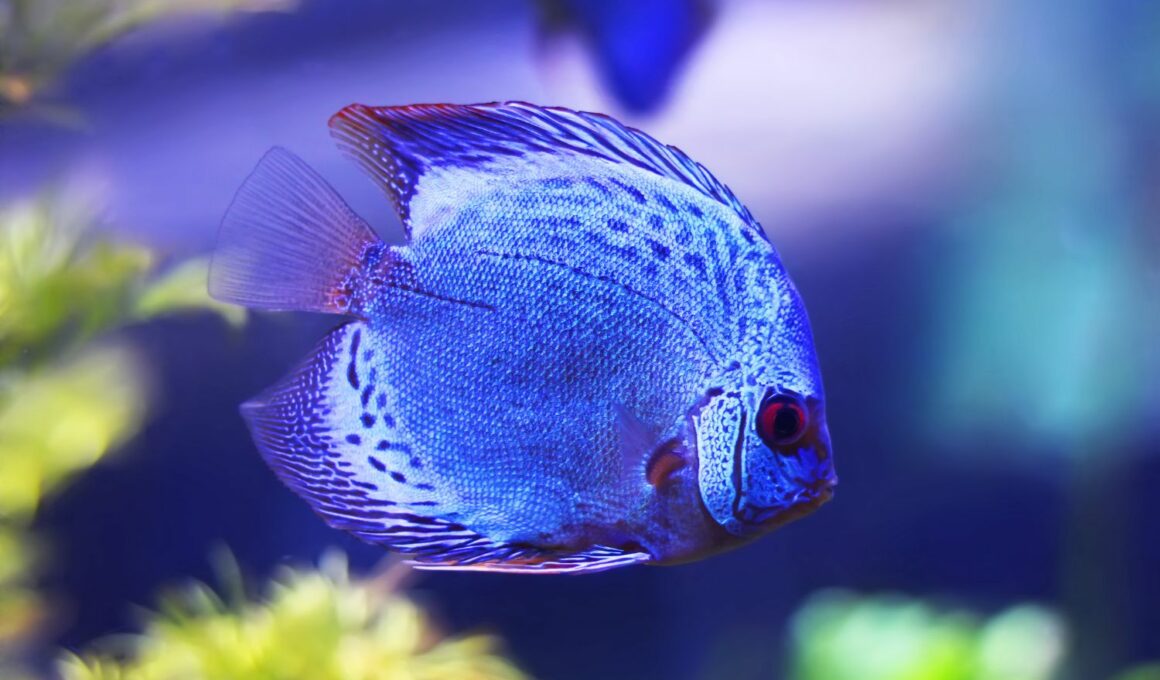In this article Show
If you’re here, it’s likely because you’ve heard about the elegant and mesmerizing Discus fish, often hailed as the “King of the Aquarium.” And rightfully so! Their vibrant colors and majestic presence can turn any aquarium into a breathtaking underwater canvas. But, like every royal, they come with their unique set of needs.
Now, having spent years nurturing these beauties in my own tanks, I’ve gathered a wealth of knowledge. And trust me, while they might be a bit more demanding than your average guppy, with the right guidance, caring for Discus fish isn’t the Herculean task it’s often made out to be.
Whether you’re a seasoned fish keeper or just setting out on your aquatic adventure, this guide aims to simplify Discus fish care for you. So, grab a note or two, and let’s dive right in!
Natural Habitat of Discus Fish
The Amazon River Basin in South America, with its sprawling, intricate waterways and tropical climate, serves as the natural habitat for the Discus fish.
This vast river system, one of the largest in the world, provides a unique environment characterized by specific factors that play a crucial role in the life and behaviors of the Discus.
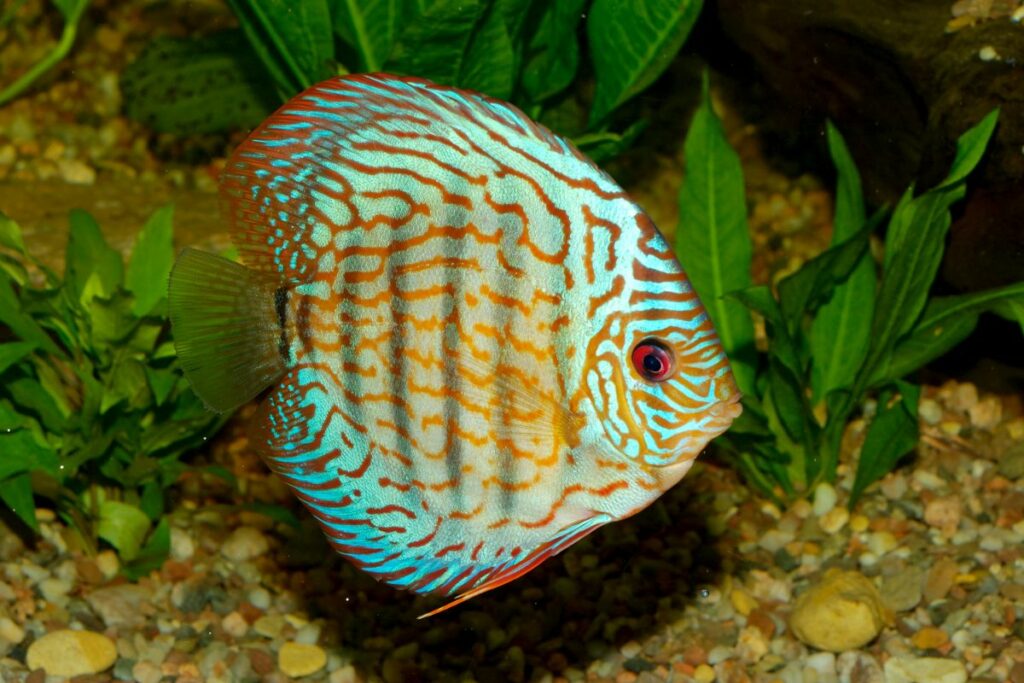
1. Water Conditions
The waters of the Amazon are warm, usually hovering around 28°C to 30°C (82°F to 86°F). It’s slightly acidic, with a pH value ranging from 6.0 to 7.0, mainly due to the decomposing organic matter and the absence of hard minerals. The water hardness is generally low, often described as soft water.
2. Submerged Landscapes
Discus fish thrive in areas with slow-moving waters. They are commonly found in river channels, lakes, and flooded forests, where the water is calm, and there’s ample shelter. Overhanging vegetation and submerged tree roots create natural hideouts, allowing them to escape from potential predators and strong currents.
3. Diet in the Wild
In their natural setting, Discus fish feed primarily on small invertebrates, algae, and zooplankton. They forage on microscopic organisms found on plant surfaces, submerged woods, and even the riverbed.
4. Social Behavior
In the wild, Discus often move in groups or schools, especially when foraging or navigating the vast waterways. This group behavior offers them protection and increased foraging efficiency.
Ideal Tank Setup for Discus Fish
Setting up a perfect home for your Discus fish requires a combination of the right tank size, water conditions, substrate, decor, and more.
A suitable tank setup mimics their natural habitat, ensuring they’re comfortable, stress-free, and primed for growth. Let’s delve into how to curate the ideal environment for these aquatic gems:
1. Tank Size
- For Single Discus Fish: A minimum of 55 gallons (209 liters) is recommended. This might sound like a lot for a single fish, but remember, Discus can grow up to 6 inches or more in diameter.
- For a Group: If you’re planning to keep a group of Discus, opt for a larger tank. A 125-gallon tank (473 liters) can comfortably house a group of 6-8 Discus.
2. Water Parameters
- Temperature: Maintain a warm environment, between 82°F to 86°F (28°C to 30°C). This warmth mimics their natural tropical setting.
- pH Level: Aim for slightly acidic water conditions, with a pH of 6.0 to 7.0.
- Hardness: Soft water is ideal, with dGH levels between 3-15.
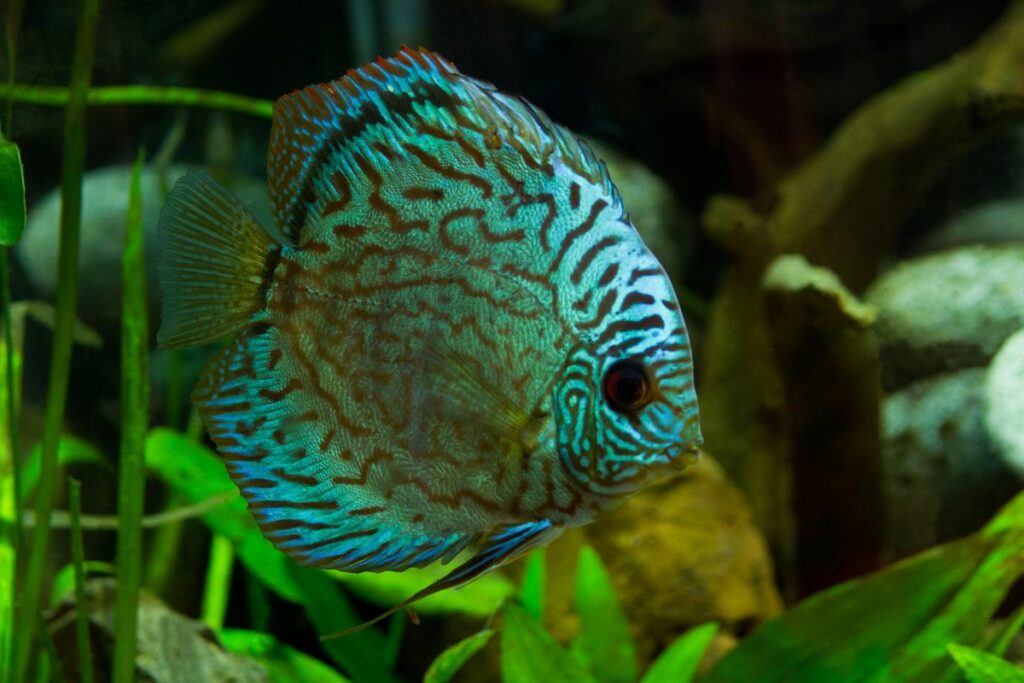
3. Substrate & Decor
- Substrate: Fine sand or smooth gravel works best. They replicate the soft bottoms of their native habitats and are gentle on the Discus’ delicate undersides.
- Plants: Opt for live plants like Amazon swords, java ferns, or Anubis. They not only provide shelter but also enhance the tank’s aesthetics. However, ensure that the plants can thrive in warmer temperatures.
- Decorations: Pieces of driftwood, and smooth rocks can be added. They serve as hiding spots and enhance the tank’s natural feel. Remember to avoid sharp or abrasive decorations that could harm the fish.
4. Filtration & Aeration
- Filtration: A high-quality filtration system is paramount. Canister filters are often recommended for Discus tanks due to their efficient mechanical, biological, and chemical filtration capabilities. Ensure it’s powerful enough to handle the tank’s volume but adjustable so as not to create excessive current.
- Aeration: While Discus don’t need a strong current, they do need well-oxygenated water. A good filter output combined with an air stone or air pump can help maintain suitable oxygen levels.
When setting up a tank for Discus, always prioritize their comfort and safety. Your goal is to recreate a slice of the Amazon River Basin right in your living room. By providing them with a habitat that closely resembles their natural environment, you’re setting the stage for your Discus to thrive and showcase their mesmerizing beauty.
Diet & Feeding for Discus Fish
Providing a balanced diet is pivotal for the health and vibrant coloration of Discus fish. In the wild, these fish enjoy a varied diet, and mimicking this variety in captivity can lead to thriving, active, and stunningly colorful Discus. Let’s explore their dietary needs and the best feeding practices:
1. Types of Food
- Commercial Food: There’s a wide range of high-quality Discus-specific pellets and flakes available in the market. These are formulated to meet their nutritional needs and often include a mix of proteins, fats, vitamins, and minerals.
- Live Food: Offering live foods like bloodworms, brine shrimp, and white worms can be a treat for Discus. They not only satisfy their predatory instincts but also provide essential nutrients.
- Frozen Food: Frozen alternatives to live food, like frozen bloodworms or beef hearts, can be a more convenient choice for many aquarists. They’re typically free from parasites and are easy to store.
- Vegetables: Occasionally, offering blanched spinach or zucchini can be beneficial. It provides dietary fiber and essential nutrients.
2. Feeding Frequency & Quantity
- Juveniles: Young Discus grow rapidly and need a lot of nutrition. Feed them 3-5 times a day, offering only what they can consume in 3-5 minutes.
- Adults: Mature Discus can be fed 1-2 times daily. Ensure that the food is consumed within 5 minutes to avoid overfeeding and the potential water quality issues it can cause.
3. Nutritional Requirements
- Proteins: Discus requires a high-protein diet for muscle development and growth. Look for foods with a protein content of around 40-50%.
- Fats: Essential for energy and growth. Foods should have a fat content of approximately 5-10%.
- Vitamins & Minerals: These support a robust immune system and overall health. Many commercial Discus foods are fortified with essential vitamins and minerals.
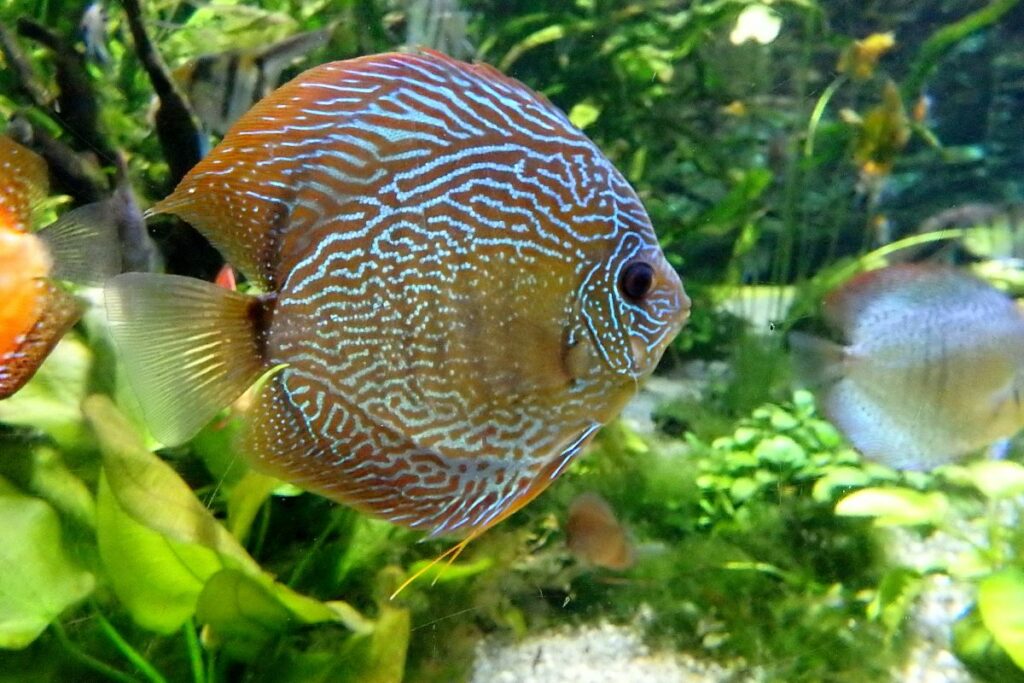
Common Health Issues & Their Prevention for Discus Fish
Just like any other aquatic species, Discus fish can face health challenges. By recognizing signs early and taking preventive measures, you can ensure a healthy and vibrant aquarium. Let’s delve into the most common health issues for Discus and how to keep them at bay.
1. Signs of a Healthy Discus
Ensuring the well-being of your Discus fish is a top priority for any aquarist. Recognizing the signs of a healthy Discus can help you feel confident in your care routine and quickly detect when something might be amiss. Here’s a comprehensive guide to discerning the health of your Discus:
Active and Alert Behavior
- Engagement: A healthy Discus will actively explore its surroundings, swim with purpose, and engage with other tank mates.
- Reactivity: When approached, a thriving Discus will respond by either moving closer out of curiosity or swimming away smoothly.
Bright and Clear Eyes
- Clarity: The eyes should be clear without any cloudiness or film, indicating good vision and the absence of infections.
- Positioning: Eyes should be proportionate to the body and not protruding or sunken in.
Consistent Eating Habits
- Appetite: A healthy Discus will have a consistent appetite, eagerly awaiting feeding times and actively foraging in the tank.
- Mouth & Gills: Check for any signs of labored breathing or difficulty in opening and closing the mouth, as this can indicate issues.
Smooth and Vibrant Scales
- Appearance: Scales should lie flat against the body without any lifts or protrusions. The color should be vibrant and consistent with the fish’s variant or type.
- Absence of Abrasions: No scrapes, cuts, or white patches should be visible, all of which can be signs of infections or injuries.
Proper Swim Posture
- Balance: A healthy Discus should swim with a balanced posture, neither sinking to the bottom nor floating up involuntarily.
- Fin Movement: All fins should move in harmony, without any jerky or erratic motions.
Robust Fins
Fullness: Fins should appear full and fanned out when the fish is alert or swimming. Clamped fins can indicate stress or illness. Fins should be free from tears, holes, or any signs of fin rot.
Regular Waste Production
This isn’t a specific disease but a term used for a range of symptoms, including lethargy, loss of color, and refusal to eat. While its causes are debated, keeping a stress-free environment and maintaining excellent water quality can help prevent it.
2. Potential Disease
- Ich (White Spot Disease): Tiny white spots on the fish’s body characterize it. Raise the tank temperature slightly (to about 86°F) and use an over-the-counter ich treatment.
- Internal Parasites: Symptoms include a thin body despite regular feeding and white, stringy feces. Treat with anti-parasitic medications and ensure you quarantine new fish before adding them to the main tank.
- Hole in the Head Disease: This manifests as pits or holes in the fish’s head. It’s believed to be caused by dietary deficiencies or internal parasites. Enhancing the diet and treating for parasites can be beneficial.
3. Maintaining Good Water Quality
- Regular Water Changes: Replace 25-30% of the tank water weekly. This helps in removing waste products and replenishing essential minerals.
- Monitor Water Parameters: Regularly test for ammonia, nitrites, nitrates, pH, and hardness. Keeping these parameters stable is essential for Discus’s health.
- Proper Filtration: Ensure your filter is adequate for the tank size and is regularly cleaned.
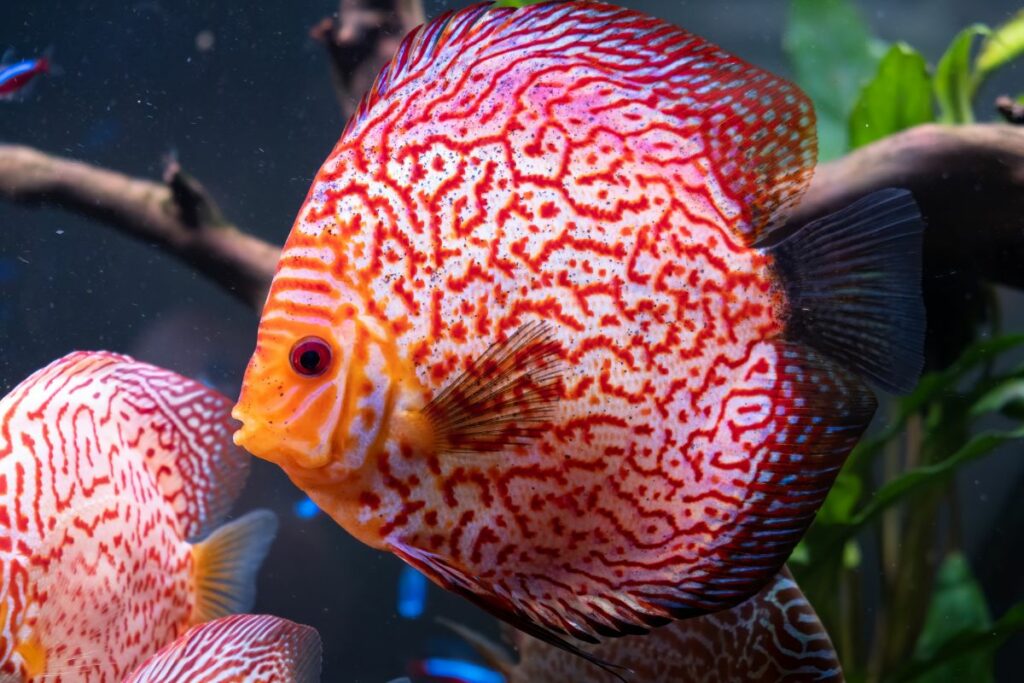
Tips for Prevention
- Quarantine: Always quarantine new fish for 2-4 weeks before introducing them to the main tank. This can prevent potential disease spread.
- Avoid Overcrowding: Overstocking can stress the fish and lead to a rapid decline in water quality.
- Diet: A balanced diet boosts the immune system. Ensure your Discus gets a mix of commercial, live, and vegetable-based foods.
- Regular Observations: Dedicate time daily to observe your fish. Noting any changes in behavior or appearance can allow for early intervention.
Lifespan & Breeding of Discus Fish
As captivating as Discus fish are in terms of their radiant colors and majestic presence, their life cycle and breeding habits further enhance their allure in the aquarist community. Dive in to understand more about their lifespan and the intricate process of breeding.
Average Lifespan
IWith proper care, including a balanced diet, stable water parameters, and a stress-free environment, Discus fish typically live for about 10 to 15 years in captivity. It’s noteworthy that their lifespan can be significantly shortened with inadequate care or persistent stressors.
Breeding Discus Fish
Discus fish form monogamous pairs, meaning they tend to stick with their mate once they’ve chosen a mate. These pairs can often be recognized by their close swimming patterns and mutual defense of a chosen territory.
Breeding Discus fish can be a rewarding, albeit somewhat challenging, endeavor for aquarists. Here’s a breakdown of the breeding process:
1. Temperature
A slightly elevated temperature, around 84°F to 88°F (29°C to 31°C), is ideal for breeding.
2. Water Parameters
Soft and slightly acidic water (pH of around 6.0 to 6.5) will provide the best conditions for spawning.
3. Spawning Site
Discus pairs will choose a vertical surface for laying eggs, like a broad leaf, the side of a terracotta pot, or even the aquarium glass. They will clean this site meticulously before the female lays the eggs.
4. Egg Care
After laying, the male fertilizes the eggs. Both parents play a role in guarding and aerating the eggs, frequently fanning them with their fins. This care helps prevent fungal growth on the eggs.
5. Hatching
In about 48-60 hours, the eggs will hatch into tiny fry, which initially feed on a gel-like secretion from the skin of both parents. This “mucus feeding” stage lasts for about a week.
6. Raising Fry
Once the fry starts swimming independently, they can be fed newly hatched brine shrimp and micron-sized foods. As they grow, they can gradually be introduced to larger foods.
Breeding Discus requires patience and keen observation. While it might be a bit challenging for newcomers, with diligence, the sight of little Discus fry thriving under the watchful eyes of their parents can be an immensely gratifying experience.
Conclusion
Caring for Discus fish is indeed a rewarding journey. You can ensure these stunning aquarium jewels thrive with a blend of knowledge, patience, and dedication. Remember, the key is to mimic their natural environment as closely as possible and to stay vigilant to their needs.






